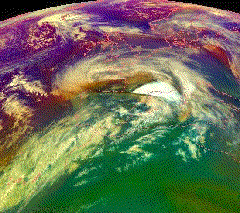Cyclone Xynthia

24-hour animation from 17:00, 27 February
|
|
| Formed | 26 February 2010 |
|---|---|
| Dissipated | 7 Μarch 2010 |
| Lowest pressure | 967 mb (28.56 inHg) |
| Highest winds | |
| Damage | €1.3–3 billion |
| Areas affected | Belgium, Denmark, France, England, Germany, Poland, Portugal, Spain, Sweden and southeast England |
Xynthia was a violent European windstorm which crossed Western Europe between 27 February and 1 March 2010. It reached a minimum pressure of 967 mb on 27 February. In France—where it was described by the civil defence as the most violent since Lothar and Martin in December 1999—at least 51 people were killed, with 12 more said to be missing. A further six people were killed in Germany, three in Spain, one in Portugal, one in Belgium and another one in England. Most of the deaths in France occurred when a powerful storm surge topped by battering waves up to 7.5 m (25 ft) high, hitting at high tide, smashed through the sea wall off the coastal town of L'Aiguillon-sur-Mer. A mobile home park built close to the sea wall was particularly hard-hit. The sea wall was about two hundred years old, built in the time of Napoleon; critics said that situating a mobile home park so close to the sea wall showed poor coastal development practices. The storm cut power to over a million homes in France and a million customers in Portugal lost power.
One million homes were left without power in western France. In the Hautes-Pyrénées, falling trees damaged vehicles, the roofs of houses and barns were blown away, and rocks were falling onto the road. In the département of Vendée, cities like La Faute-sur-Mer, L'Aiguillon-sur-Mer, La Tranche-sur-Mer were flooded with water levels reaching up to 1.5 metres (4 ft 11 in). Flooding affected parts of the Charente-Maritime département (Suburbs of La Rochelle, cities of Fouras, Marennes, Châtelaillon as well as Ré and Oléron Island) where high speed wind were registered (160 km/h).
...
Wikipedia
